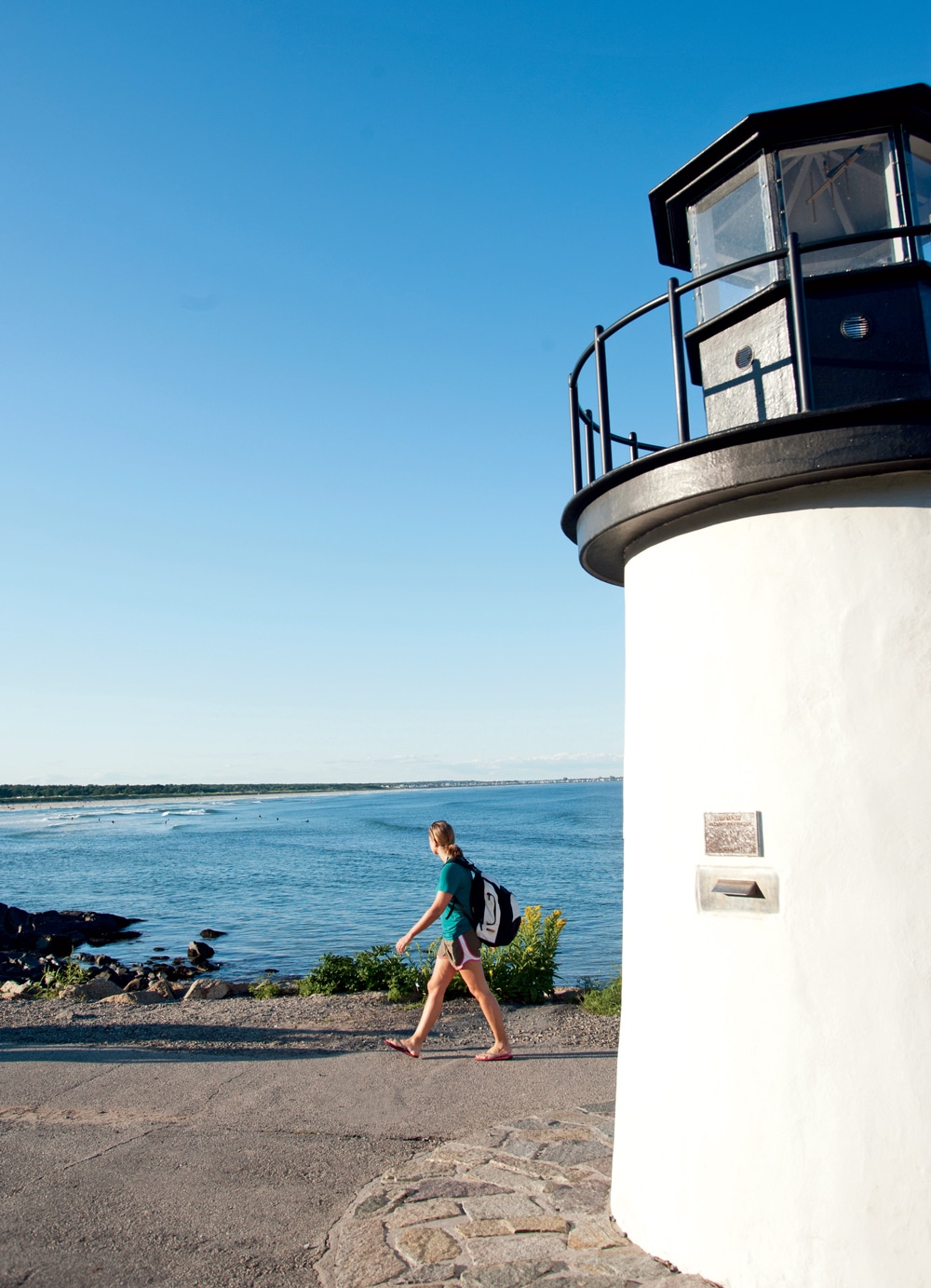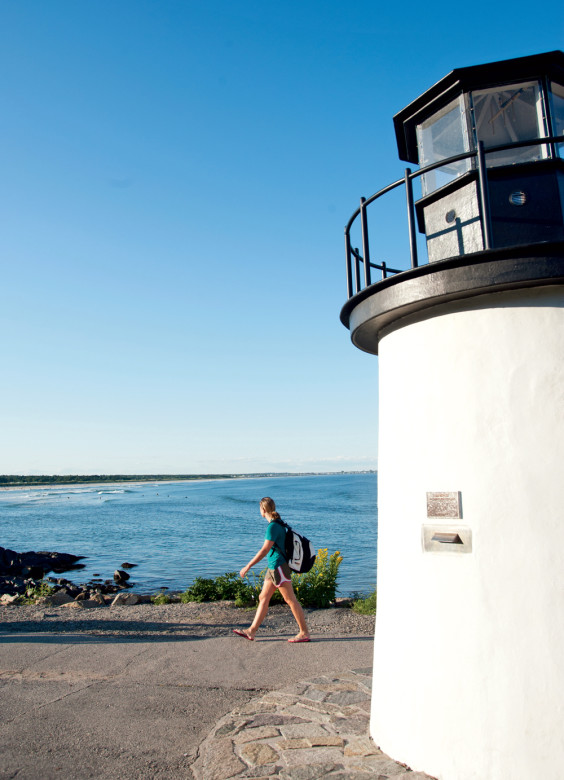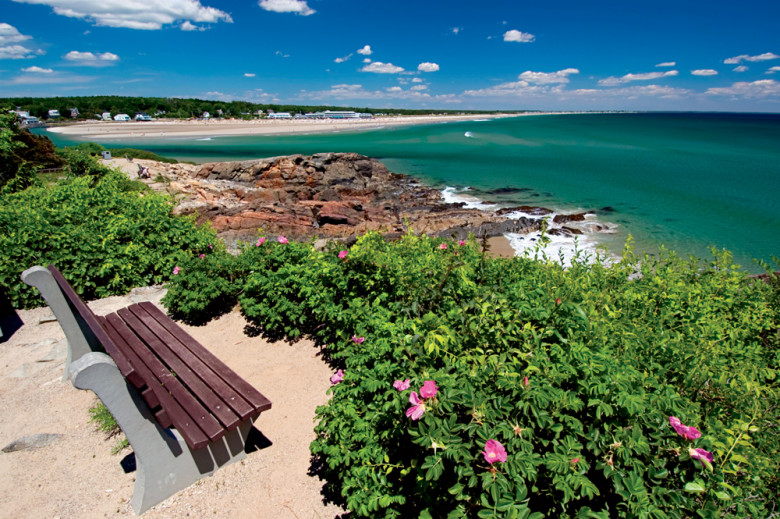A Walk That Says Maine | Ogunquit’s Marginal Way
Ogunquit’s Marginal Way is a love story about a town and its ocean.

Coffee By Design | Portland, Maine
Photo Credit : Katherine Keenan
Photo Credit : Kindra Clineff
This is what it feels like to be a seabird, a poet, a pirate, on top of the world. To take a vertiginous walk on the edge of beauty, high over the ocean, while waves pound rocks into sculptures far below, and toss starfish and tiny shells into tidal pools scooped out like cauldrons brewing the ultimate plateau de fruits de mer.
Take a deep blue breath of Atlantic air and step onto the Marginal Way, which winds from Ogunquit Beach to tiny Perkins Cove, a collection of onetime fishing shacks now refurbished as shops and restaurants, shining like a periwinkle on the far side. People get married on the Marginal Way. Others want to have their ashes scattered into the sea here. Strollers transport infants on their first-ever cliff “walk”; a wheelchair, available at the town fire station, assists those who need it. Birth, marriage, and death—as well as an overarching splendor that speaks to the inner stillness that guides us all—share the path.
“People have their memories here,” says Paul Breen, 81, who has lived in Ogunquit year-round for the past 10 years; he’s also summered here since ’68. He walks the Marginal Way every day, patrolling for erosion (he’s president of the Marginal Way Preservation Fund) and checking in on one particular bench—his memorial to the daughter lost to lupus—among the 39 that line the path. Like people choosing their favorite view, these benches face the horizon, engulfed by beach roses, or sit sequestered in a cedar grove, or perch on the cliff’s edge. There’s a bench for every mood, every season, every conceivable kind of vista.
It’s all impossible to resist, and why would you? The story of this strip of coast “on the margin” unfurls like a love story between the town of Ogunquit and the sea. To most, the Marginal Way is Ogunquit. Deeded to the town in 1923 by Josiah Chase, a retired lawyer from Portland, Maine, the granite-cliff pathway was added to over time by abutters who contributed easements to create the stretch of path we know today: an easy mile-plus meander. Start near Ogunquit Beach and search for tucked-away Wharf Lane if you want a sneak preview, or duck down the “official” trail entrance near the Sparhawk Resort. Some know the landmarks like their own children: Little Beach, Mother’s Beach, Devil’s Kitchen, the Marginal Way Lighthouse (with online daily views from a webcam).

Photo Credit : Rubens Abboud/Alamy Stock Photo
Louesa Mace Gillespie, 80, grew up on the Marginal Way—her family owns the Beachmere Inn, an expansive compound overlooking the churning Maine water. She remembers biking the path decades ago, in the early 1940s. “It was a dirt path across the property,” she says. “You could ride your bike right out to the Cliff House.” But not everyone took the path, she recalls: “When I was a kid, you were a wimp if you touched foot on the Marginal Way. You had to do it on the rocks!”
It’s a funny thing about this cliff walk: You’re almost never alone, but it’s still plenty meditative. You’ll pass sunbathers, bench sitters, chess players, shutterbugs, musicians, painters, and kids clambering over boulders. Everyone finding their own little corner. Lots of everyones. In fact, to gather hard data about the ongoing problem of erosion (apart from natural causes), the town’s Marginal Way committee installed a people counter last year. On Fourth of July weekend, some 12,000 people walked by; in August, the tally was 97,000.
But this is much more than a tourist stroll. Ogunquit villagers are fierce about their walk. The town and various Marginal Way groups, both municipal and nonprofit, work overtime to maintain it: trimming back daily the invasive species and shoring up collapsing stretches of pathway. They’re holding back the sea. Rebuilding benches. Constantly fund-raising (though there’s a moratorium on adding benches, a Friends of the Marginal Way memorial has been created, a pretty granite alcove with name plaques available). And they’re even replacing sections of path: In 2007, a terrible storm “tore apart the Marginal Way,” says Breen, with over $2 million in damage.
It’s that mighty power that keeps us awestruck. Waves crashing, foam flying. The spectacle of this view, with such amazingly easy access (foot traffic is encouraged all along the way, with seven entrances). The gently rolling nature of the trail, making it a friendly walk for young and old. And always another bench around the corner, just begging you to sit and contemplate a view that stretches all the way to Spain.
“When you’re a kid, you say, ‘I’m never going to sit on those benches,’” says Gillespie. She glances out toward the water, and a path that has drifted along this coast for decades. “And then, when you’re my age, you think … it might be nice to sit on a bench and watch the surfers.”








My husband and I visited Ogunqut many times from Dallas, Texas. We especially loved the Marginal way and I wondered if it was still possible to inscribe a loved one on a bench. He has passed away and I would love to put his name in memory on a bench. Please let me know if this is still possible and what the charge is. Thank you, Elaine (wish I was there now!)
We spent last weekend on the Marginal Way. To be able to, experience and photograph a sunrise was amazing!
I sure miss Lord’s beach in Wells. We used to be able to walk there from the farm.